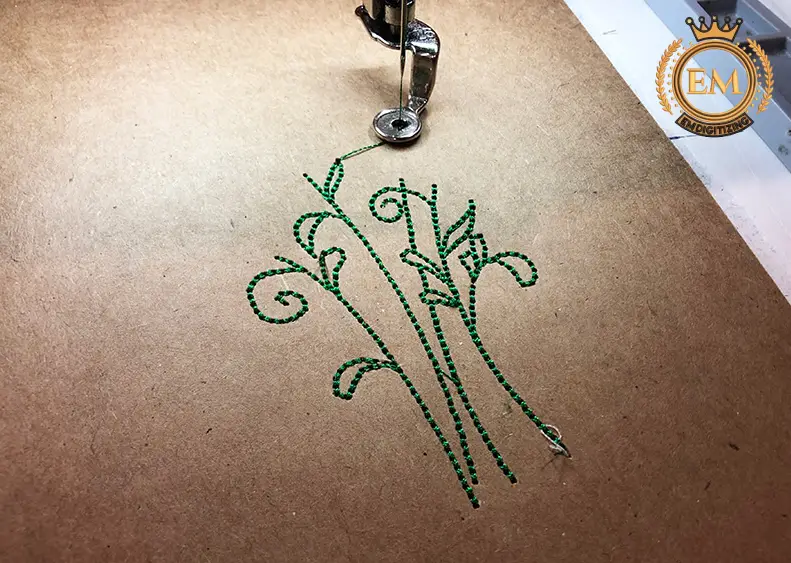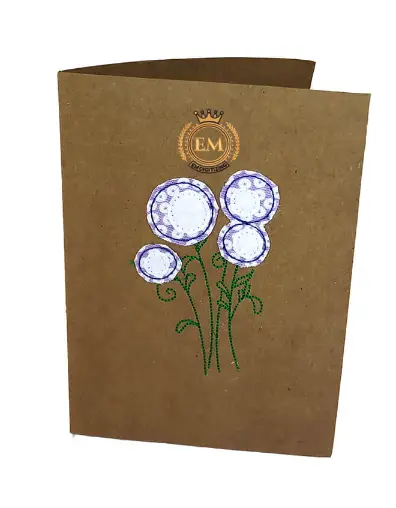
Embroider on paper cards, gift tags, and other fun paper items is a unique way to use your embroidery machine! While choosing the best combination of stabilizzatore, disegno, and paper to get the best results with paper embroidery can seem daunting, I have some tips to help you learn how to embroider on Paper Card.
Supplies for machine embroidering on Paper Cards
Servizi di digitalizzazione del ricamo
Why Embroider on Paper Cards made of watercolor papers?
In our digital era, an embroidered card looks rich, customized, and unique. Tuttavia, the cost and time to build one are very low. Plus –; you can completely customize the card for any recipient. Just load a different disegno and add a name.
The cards are usually not very large. So if you only have a small embroidery hoop, this is a great project to start with. Embroidery on cards is a great way to get comfortable with your macchina da ricamo.
What type of Cards Should You Embroider?
There are basically two ways to embroider a card. You can either embroider it on paper and then glue it to the front of a plain note card. In alternativa, you can just embroider on the front of the notecard. Whichever method you choose, you’;ll need to choose a paper that’;s durable enough to withstand needle punctures from stitching the disegno del ricamo. Watercolor paper or card stock works well.
Keep in mind that if you sew the disegno del ricamo onto the front of the folded card, the ugly, back side of the embroidery will be on the inside of the card. That’;s why you cover the inside of the card with a piece of paper.
Best stabilizer for embroidery on paper
As with most paper types, stabilizzatore tagliato (or PolyMesh) makes excellent greeting cards. It supports stitches well, especially with denser designs and flimsier papers. While you can peel the cutaway stabilizer away from the design after sewing, you will still have one left under the design. This can easily be covered with an additional piece of cardstock.
As much as I’;d like to use Tearaway Stabilizer to embellish the back of the design, it doesn’;t really produce great results.
If you’;re looking for a fun effect, però, try dense satin stitching on the card with a tear-away stabilizer. You will get a 3D effect like tearing down my fluttering butterfly thanks!
Il miglior ago per ricamare su carta
Più grande è l'ago, più grande sarà il buco.
così, mentre serve un ago abbastanza spesso da forare la carta, vuoi scegliere la dimensione più piccola possibile per evitare di forare la carta. Scegli una taglia più piccola come 75/11 o 70/10, ma assicurati che l'occhio sia abbastanza grande per la selezione del filo. Se uno ago da ricamo doesn’;non fare il trucco, aumentare la taglia e utilizzare un ago da cucito affilato per creare un foro pulito.
Per ricamo su carta, it’;È anche meglio prenderne uno fresco, nuovo ago dalla confezione. Gli aghi lenti causeranno solo problemi.
Tipi di thread
Molti tipi diversi di filo funzionerà per il ricamo su carta. La cosa più importante è assicurarti che il tuo thread e scelte dell'ago sono compatibili. Fili decorativi, Per esempio, don’;Funziona bene con un ago con una cruna piccola.
Maggior parte disegni da ricamo sono digitalizzati per filo da 40wt, ma puoi scegliere un peso diverso. Mentre tendo a sbagliare usando il mio filo di poliestere o rayon 40wt preferito, ecco alcune altre divertenti opzioni di filo per il ricamo delle carte:
- Utilizzare diversi pesi di filo di cotone (prova 30wt!) per imitare l'aspetto del ricamo cucito a mano.
- Filo metallico
- Filo che si illumina al buio (Imparare come realizzare fili per macchine da ricamo che si illuminano al buio!)
- Discussione diversificata
Disegni di ricamo a macchina per carta di carta
La scelta di un disegno è la chiave per un oggetto di carta perfettamente ricamato, especially if you’;stai usando carta sottile.
La cosa principale da ricordare è che i disegni a punto pieno densi e i disegni con punti di rinforzo prominenti non avranno un bell'aspetto quanto quelli più aperti, disegni meno densi con un numero di punti inferiore. Mentre le applicazioni sono possibili, è necessario puntare ad una grande stabilità e ad una stabilità molto elevata, carta fibrosa affinché funzionino bene.
Caratteristiche del design più adatte per il ricamo su carta:
- Redwork, punto catenella, o disegno di contorno
- Esecuzione dei caratteri Stitch.
- Se il sottofondo viene rimosso e il numero di punti viene ridotto, disegno con punto di riempimento (aumentando la lunghezza del punto o modificando la densità).
- Disegni digitalizzati specifico per cartoncino (Ricamodesigns.com, Oma’;s Luogo, e SWAK Ricamo sono fonti di immagini utilizzate in questo tutorial.)
- Minimize jump stitches if you don’;Non hai una macchina che li taglia automaticamente per te.
E, poiché i fori dell'ago sono permanenti, make sure the needle isn’;t poking down anywhere and it won’;nemmeno cucire!
Tecniche decorative per realizzare ricami su cartoncini
sì, i tipi di disegni che puoi cucire sui biglietti possono essere un po' limitati, ma ci sono molte tecniche che puoi utilizzare per rendere i tuoi biglietti ricamati davvero unici.
- Cuci l'intero disegno su un cartoncino blu o nero con filo bianco.
- Cuci un disegno colorato, si illuminano al buio, o filo da ricamo metallico per aggiungere un arcobaleno di colori.
- Migliora la tua carta con una perforatrice per carta e una fascetta a nastro
- Combina disegni ricamati con stampe o scritte decorative.
Le possibilità sono infinite.
Suggerimenti su come ricamare su cartoncini di carta
- Cuci su cartoncino di alta qualità, carta da acquerello, o altra carta pesante senza elementi decorativi come foglie o fiori incastonati.
- Funzionerà anche la carta a grana lunga, ma prova prima.
- Usa uno stabilizzatore tagliato per un supporto extra.
- Fai galleggiare la tua carta sullo stabilizzatore nel telaio fissato con uno spray adesivo temporaneo.
- Use a small sharp needle, taglia 11 o più piccolo, to avoid large holes.
- Consider slowing down your machine.
- Add scrapbook paper to cover the back of the stitch.
- Consider adding extra embellishments with colored pencils.
How to Embroider on Paper Card Tutorial
I started this project by finding a boring, brown color paper card. It’;s so dull that I can’;t imagine what I’;d use it for. Il disegno del ricamo I used to stitch on the card was one I digitized a while back, a whimsical flower bouquet appliqué.

Fare un passo 1: Hoop a piece of stabilizer
I think you can really get away with any tipo di stabilizzatore for this project. I applied a piece of adhesive-backed tearaway stabilizer, but I’;ve heard of people using regular tearaway or cut-away stabilizer as well. After hooping the stabilizer, mark the center of the hooped stabilizer using a disappearing ink pen and extend the center lines vertically and horizontally.
Fare un passo 2: Float the card

If you are using an adhesive-backed tearaway stabilizer, score the inside edge of the stabilizer with a pin to tear the top layer of paper. Prossimo, peel off the paper to expose the sticky surface. If you are using a regular tearaway or cutaway stabilizer, you will need to spray the stabilizer with a temporary adhesive. Glue the card onto the stabilizer so that the center of the card aligns with the center of the hooped stabilizer.
Fare un passo 3: Start sewing on your design
Listening to the needles pierce through the card is very satisfying.

Fare un passo 4: Remove the card from the hoop
If you are using a tearaway stabilizer, make sure you tear the stabilizer and not when removing the card from the hoop.
Fare un passo 5: Add some finishing touches
Using embroidery nippers, cut your strings from your design. Since the design I made was a raw edge applique design, I also needed to trim my fabric using applique scissors.

Conclusione
I hope you have now learned a fun new application for your embroidery machine: embroider on paper card!
Transfer the tracing paper and embroider the design, working directly through the fabric and following the pattern markings. Use a backstitch, a tightly worked stem stitch, and a closely spaced stitch to outline your design. Separate chain stitches will sew easily while extra care is required when removing the paper.
sì, you can embroider on paper card!
Whether you’;re teaching kids to sew, embellishing blank greeting cards, or adding color to scrapbook pages, paper is an inexpensive way to get creative. Decorative stitches were sewn with colorful thread to add a wonderful pop of color to any paper craft.
Card stock
Any heavy-weight paper (cardstock) will be fine. I’;ve embroidered on several different types: paper from an artist’;s watercolor pad, a short fiber tag board, and expensive handmade paper. I’;ve had the best results with heavier paper that has longer fibers.
The main categories are free or surface embroidery, counted embroidery, and needlepoint or canvas work. In surface embroidery, designs are applied without regard to the weave of the underlying fabric. Examples include Creole and traditional Chinese and Japanese embroidery.
There are basically two ways to embroider a card. You can either embroider it on paper and then glue it to the front of a plain note card. In alternativa, you can just embroider on the front of the notecard.
